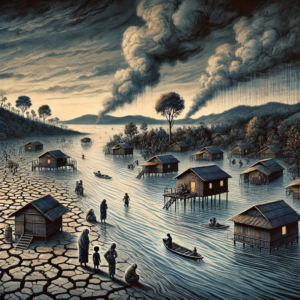Introduction
Overview of Climate Change: Briefly explain climate change, its causes, and its increasing severity.
•Focus on Vulnerable Communities: Discuss why low-income and marginalized communities are especially at risk.
•Purpose of the Article: Outline the structure and the key areas you will address.
Section 1: Understanding Vulnerable Communities
•Definition and Characteristics: Define what makes a community vulnerable.
•Factors Contributing to Vulnerability: Low income, limited access to resources, healthcare disparities, and geographic factors (e.g., coastal communities).
Section 2: Impacts of Climate Change on Vulnerable Communities
1.Health Risks:
•Effects of air pollution and heatwaves on public health.
•Increase in respiratory diseases and heat-related illnesses.
2.Economic Impacts:
•Loss of livelihoods due to changing agricultural patterns and extreme weather.
•Rising costs associated with property damage and healthcare.
3.Food and Water Security:
•Impact on agriculture leading to food shortages and higher prices.
•Water scarcity and the challenges for communities with limited infrastructure.
4.Social Displacement and Migration:
•The rise in climate refugees and internal displacement.
•Social and economic strain in both origin and host communities.
5.Mental Health and Wellbeing:
•Stress and anxiety linked to frequent climate-related disasters.
Section 3: Challenges Facing Vulnerable Communities in Responding to Climate Change
1.Limited Resources for Adaptation:
•Financial constraints preventing protective infrastructure.
•Lack of access to climate information and technology.
2.Policy and Governance Barriers:
•Inadequate support from local and national governments.
•The challenge of integrating community voices in climate policies.
3.Health Infrastructure Gaps:
•Limited healthcare facilities in vulnerable areas.
•Insufficient preparation for climate-related health crises.
4.Economic Dependence on High-Risk Industries:
•Reliance on agriculture, fishing, or tourism, which are climate-sensitive sectors.
Section 4: Solutions and Mitigation Strategies
1.Strengthening Resilience through Community Programs:
•Empowering communities with knowledge and skills for climate adaptation.
•Community-led initiatives in sustainable agriculture and conservation.
2.Policy Recommendations:
•Advocating for inclusive climate policies that prioritize vulnerable communities.
•Implementation of social safety nets and economic diversification.
3.Investment in Green Infrastructure:
•Building resilient infrastructure, such as flood defenses and water storage systems.
•Promoting clean energy solutions accessible to vulnerable populations.
4.International Cooperation and Funding:
•The role of international aid and development banks in providing resources.
•Climate financing mechanisms aimed at the most affected regions.
5.Public Health Initiatives:
•Expanding healthcare access and creating climate-responsive health systems.
•Programs for mental health support in disaster-prone areas.
Conclusion
•Summary of Key Points: Reiterate the major impacts and challenges.
•Call to Action: Emphasize the need for urgent action at local, national, and international levels.
•Future Outlook: Discuss the importance of long-term strategies for supporting vulnerable communities.
Expanding Each Section with Detailed Analysis
Section 1: Understanding Vulnerable Communities
•Research Examples: Integrate specific cases of vulnerable communities worldwide (e.g., Pacific Island nations affected by rising sea levels, drought-impacted communities in sub-Saharan Africa).
•Statistics and Demographics: Include relevant statistics that highlight the disproportionate exposure to climate impacts among low-income populations. This data grounds the section in real-world evidence.
Section 2: Impacts of Climate Change on Vulnerable Communities
•Detailed Case Studies: Use real-life examples to illustrate each impact, such as a particular community that experienced a catastrophic flood, highlighting the economic and social repercussions.
•Data Analysis: Incorporate scientific data on temperature increases, extreme weather patterns, or food security challenges, explaining how these specifically worsen conditions in these communities.
Section 3: Challenges Facing Vulnerable Communities in Responding to Climate Change
•Barriers to Adaptation: Describe common obstacles, like inadequate housing unable to withstand extreme weather, or a lack of disaster preparedness plans.
•Policy Shortcomings: Analyze where policy failures occur, such as insufficient funding, and suggest how policies could be reformed to better protect at-risk populations.
•Quotes and Interviews: If possible, include perspectives from residents, community leaders, or experts to convey personal insights on these challenges.
Section 4: Solutions and Mitigation Strategies
•Community Empowerment Projects: Provide examples of successful local initiatives, like sustainable farming projects or water conservation efforts.
•International Collaboration: Explain the role of global agreements like the Paris Agreement and how specific provisions target support for vulnerable countries.
•Detailed Recommendations: Outline actionable steps, such as promoting climate education, increasing healthcare resources, or developing more inclusive infrastructure. Highlight both short-term and long-term solutions.
Conclusion: A Compelling Wrap-Up
•Restate Urgency: Summarize the critical need to address these issues proactively, given the accelerating pace of climate change.
•Future Directions: Suggest next steps, like fostering climate resilience through innovation, or involving young voices in climate action.

